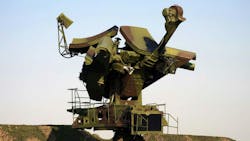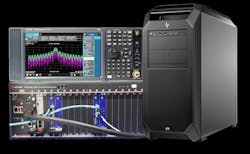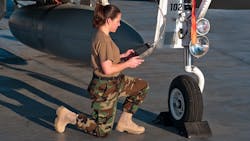Electronic-Warfare Testing: Advanced Techniques with Real-World Data
What you'll learn:
- The importance of electronic-warfare test.
- How recording and playback of real-world data can improve performance assessments.
Success in any defense mission means prevailing in the electromagnetic spectrum operations (EMSO) environment. Today’s radio-frequency (RF) spectrum environment is becoming increasingly unpredictable, as new threats emerge continuously from often unknown sources. To know that a system will perform in the face of threats, developers ideally simulate the operation planned in the actual mission.
As recording and playback technologies rapidly evolve to better capture the actual RF environment, system developers can rely on streaming to test system performance. Armed with this capability, developers will see if their system responds with appropriate—and successful—countermeasures in a conflict scenario.
A variety of use cases exist for record and playback capabilities. For example, a team may want to perform spectrum monitoring of a dense spectral environment. Here, the goal is to capture everything in a wide bandwidth and record that to storage, so that it can be analyzed in detail afterward.
In this scenario, developers often look for particular signals of interest like interferers. They want to monitor the spectrum to make sure there are no malicious interferers and no non-cooperative interferences. Usually, the latter problem arises when other commercial-type transmitters impose on bands that should ideally stay clean of interferers or problem signals.
In aerospace and defense, a common use case for testing is free space testing. It involves large-scale exercises with multiple platforms, including aircraft and ground assets, and requires analyzing a wide range of communication signals and spectrum activity.
Here, the developer may have a need for a ground sensor during a test, which individually records and collects time-stamped data on what's going on in the spectrum. That data can be correlated to specific test activities. If certain effects occur throughout a mission, the developers can then correlate that event to exactly what was happening within the spectrum.
Record and Playback for Electronic Warfare
In terms of electronic warfare (EW), recording and playback can improve performance assessments for the myriad systems encountered. Examples include jamming platforms, radars, ground and airborne systems, satellite communications, and general spectrum operations. The goal of recording is to access the truth source for whatever test activity is occurring, as streaming provides 100% probability of intercept for spurious signals.
This information goes beyond just a picture or trace of the spectrum, providing the actual point-by-point, sampled data of all signal activity. With modern streaming solutions providing long-term storage, the advantage is a gapless, wideband, running truth source for potentially hours of time (Fig. 1).
For best results in gauging actual system response and performance, the system developer should not use a clean environment. Ideally, the developer should have access to a comprehensive range of signals, or “clutter,” in the environment. This includes cellular, Wi-Fi, commercial radar, marine, and air traffic signals. Everything should be captured, independent of analysis by engineers.
Recording technologies are rapidly evolving to better capture the actual environment. By layering these different recordings, it’s possible to play them on top or with the EW-specific signals.
If a test involves multiple units or branches of the military or government working in conjunction, for example, the goal is to test different types of signal activity. The operators want to see how effectively these systems can come together in an operation. Such tests must contend with the complexities of the spectrum growing more crowded as well as each individual platform’s multiple functions, and therefore signals.
An airborne platform, for instance, will likely have a jammer and altimeters as well as communications to ground units and communications air to air. It may be doing its own radar tracking on other targets, such as missile tracking.
In the test scenario, many different systems in addition to the airborne platform are transmitting waveforms and performing spectral activities. If one source can capture all of that activity or at least collect a large portion of the spectrum, that recording and data can be correlated to certain assets and functions. The developer can then identify what's happening and how other systems respond or are impacted.
Jamming is an example of a system failing to overcome a threat. The goal is to look at a number of different systems, their behavior, and their purposes in the spectrum. By recording a radar platform, one can see how it responds to a non-cooperative environment.
Modern Radar in Electronic Warfare
Radar systems play a critical role in the EW ecosystem. They must advance to contend with evolving threats in the dense spectrum environment; as it is, they're currently designed to be more intelligent and automated.
Radar systems may switch modes or channels, searching for clear channels. Once the system encounters jamming or a lot of other activity in the operating band, a radar should respond in a way that preserves its advantage in the operational environment. For radar-system developers, the goal is to see the jamming or spectrum interference begin and assess whether the radar responds accordingly, with the goal of avoiding the jammed portions of spectrum.
For threat simulation in particular, developers can take a recording of a very high-fidelity system in a realistic environment into a lab. There, it can be run through radar warning receivers (RWRs) via a lab bench setup. With that recording running, the developer can create techniques in response to it, repeatedly in a closed environment with no risk to physical or human assets.
If an airborne platform is flying into threat territory, an RWR functions as a receiver looking at the environment. If it sees signals, it matches them up—possibly to a known library. It then summarizes, based on these parameters, the frequency, what the pulses are doing, the threat or type of threat, and the threat location and/or direction it's moving. This approach alerts the pilot to the threat so that they can decide how to respond.
Recording for Mission Success
To develop effective countermeasures, it’s crucial to be able to play the recording of new threats. Those recordings also must be inserted into the systems on the plane or other vehicle so they can view it. The EW test system can then verify if the system is detecting the threat and how it's responding.
Introducing that signal into the system requires a flexible architecture for the reprogramming environment. Think of it as a benchtop system of systems. In addition to harnessing the information about the new threat, the system needs to simultaneously consider any preexisting threats and information regarding the environment.
Here's where data advances like machine learning greatly improve capabilities. In the past, a team of analysts would require a week or two to analyze this data, trying to detect and identify all signals of interest. They will rely on custom scripts and need to manually break up large binary files, using software tools to parse the data with custom scripts.
Today, much innovation focuses on the challenge of managing big datasets of raw RF. New options increasingly allow signals and signal events to be identified in real-time, presenting clean results once the recordings are completed.
Performance Needs: Where To Start
With myriad use cases and surprises in the spectrum environment, system developers need confidence in system performance for diverse mission scenarios. To help determine their needs, they should consider what they're searching for during testing.
For example, the priority could be zooming in on a small frequency band or capturing a broader picture. Ideally, the system developer will have some idea of other signals in the environment in which they’re transmitting. This knowledge helps direct whether they need to monitor multiple aspects or systems within the same spectrum.
Developers also need to consider if their testing will be done free space or direct-coupled. With free space, the recorder is plugged into some cabling that’s attached to an antenna. That antenna may be pointed at something of interest to collect the signals coming off a specific system, such as an airborne or ground-based platform. Alternatively, they can use an omnidirectional antenna that collects data from a much larger area, picking up anything that transmits to the antenna location.
While the antenna approach provides a kind of ground truth, having the signal collection be direct-coupled through an instrument such as a handheld network analyzer (Fig. 2) may be more suitable for the radar. With the transmitter and receiver chain and potentially coupled ports that could be tapped, it’s possible to record everything coming off the radar. However, this approach delivers findings that are somewhat isolated from the surrounding area, as the developer is only looking at the connected hardware.
The recording system connects directly off a system transmitter or maybe through the receive path to see what the radar sees. With a direct-coupled approach, remember that the findings relate only to a specific system and test point, as opposed to free space, where the developer would see everything going on in the environment.
Simulation in the Future: Leveraging Real-Time Analysis
The next stage of these real-world simulations will see improvements in real-time analysis. Traditionally, the spectrum environment and related data are captured independent of analysis. The engineers and analysts must post-process this data to gain insight into the test objective. By bringing the analysis into real-time, intelligence will be available as soon as the test and signal capture are complete.
For example, a machine-learning-based analysis tool can take these long-term, wide-bandwidth RF recordings to perform energy detection on the signal data. It classifies the signals coming off that energy detection, identifies them, and then does unsupervised clustering of that data. Essentially, it builds a database of what it has identified in the data.
At the end of the processing, the developer can then interact with the data and filter out everything they're not concerned about. They're able to parameterize the data around the things of interest and kind of zoom in on the very narrow pieces of signal events of interest. With these improvements, the tools can help developers find a needle in a haystack—quite a challenge when the haystack is terabytes worth of RF data.
With these advances, EW and radar system developers will increasingly leverage independent capture of a large portion of spectrum, collecting it and correlating it to specific signal sources and events.
As innovations continue to enhance recording and playback solutions, they will push the boundaries of higher frequencies and wider bandwidths in keeping with military systems, providing key insights into system performance as spectrum grows ever denser and more complex. Armed with these capabilities, developers can better predict performance against threats so that the mission isn't jeopardized.
About the Author

Nancy Friedrich
RF Product Marketing Manager for Aerospace Defense, Keysight Technologies
Nancy Friedrich is RF Product Marketing Manager for Aerospace Defense at Keysight Technologies. Nancy Friedrich started a career in engineering media about two decades ago with a stint editing copy and writing news for Electronic Design. A few years later, she began writing full time as technology editor at Wireless Systems Design. In 2005, Nancy was named editor-in-chief of Microwaves & RF, a position she held (along with other positions as group content head) until 2018. Nancy then moved to a position at UBM, where she was editor-in-chief of Design News and content director for tradeshows including DesignCon, ESC, and the Smart Manufacturing shows.


